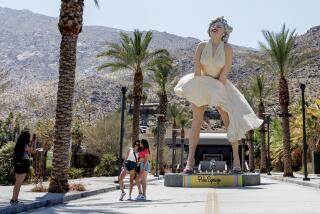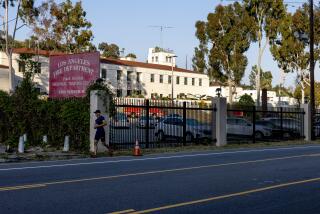Depot Running Late on Trip to New Home
- Share via
FILLMORE — What was supposed to be a quick 1 1/2-block journey Wednesday for a 110-year-old railroad depot turned into a marathon ordeal for moving crews.
Potholes, a light pole, electrical wires and the necessity of maneuvering around the city’s fire station proved difficult for a four-person house-moving crew, which was shuttling the depot that houses the Fillmore Historical Museum to its new home.
Hydraulic jacks raised the yellow wooden building, which is more than 100 feet long, as lumber the size of railroad ties supported it. Then a big rig and tow truck gingerly began the journey.
“At one point, the building was actually touching the fire station roof,” Martha Gentry, president of the Fillmore Historical Society, said about 6:30 p.m. “It’s been moving by inches for the last two hours. It’s absolutely fascinating they can do something like that.”
Work began about 1 p.m. and, as darkness fell 5 1/2 hours later, the depot still blocked Main Street. The Big Bear-based moving crew had predicted that the job would take about an hour.
“Once they get it into the street and pointed in the right direction, we’ll be on easy street,” said Rochelle McKinnon, the society’s executive director.
Gentry expected that the building would be left overnight on a vacant lot adjacent to its final resting place and be placed in position today.
The 1887 landmark is the final structure from the museum’s present location at 447 Main St. to be moved to Fillmore Historic Park at 350 Main St., adjacent to the railroad tracks. The move is costing the society $14,000.
A 1956 Southern Pacific railroad car and a small post office from the nearby community of Bardsdale had already made the short trek.
When it opens in May 1998, the park will also include the Hinckley House, which was the home in 1905 of the Santa Clara Valley community’s first dentist and druggist, and a 1919 farm worker bunkhouse that itself made a six-mile trip in February 1995.
It is the second move for the railroad depot in a quarter of a century.
The depot was moved 100 yards or so from its original site in 1974 after a local patron purchased it for $1 and paid the moving costs.
The historic site is part of a larger economic development project on former railroad property intended to revitalize the town and attract tourists.
The project will eventually include a winery, stores, a new city hall and park, 90-foot train turntable and railroad-related displays.
More to Read
Sign up for Essential California
The most important California stories and recommendations in your inbox every morning.
You may occasionally receive promotional content from the Los Angeles Times.













